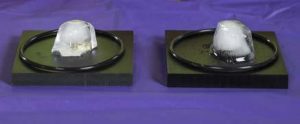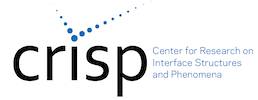Our kits are currently being reviewed and updated by a team of collaborative, innovative and interdisciplinary educators who wish to enhance the educational opportunities for students. These dedicated teachers are members of CRISP Collaborative Science for All (CCSA) as well as local educators.
Click to see the SCSU CRISP Module Template used by CCSA for improving and updating the CRISP demos and kits. Each kit page offers a CRISP developed teacher module and CRISP aligned standards (both NGSS and CCSS)
Kit Request form

Heat can be transferred by conduction, convection, or radiation. In this activity, students will discover the different rates at which materials can conduct heat. Aluminum is a better conductor of heat than high-density foam. The difference happens because of thermal conductivity. Thermal conductivity measures how quickly heat flows through a material. The aluminum has a higher thermal conductivity and the foam has a lower thermal conductivity
Adapted from NanoDays Toolkits originally created for NISEnet via the NanoDays project
This material is based upon work supported by the National Science Foundation Award Numbers 0532536 and 0940143. Any opinions, findings, and conclusions expressed in this material are those of the authors and do not necessarily reflect the views of the National Science Foundation.
Subject(s):
Conductivity, Energy, Properties of Materials
Objectives:
Students will learn:
- Thermal conductivity can be higher or lower for different materials
- The way a material behaves on the macro scale depends on its nanoscale structure
Vocabulary:
Thermal conductivity, Graphene, Graphite
Materials in this kit:
- Black aluminum block
- Black high-density foam block
- 2 black o-rings
- Pyrolytic graphite piece
- Sponge
- Insulated bag
- “Thermal conductivity of Graphene” page (NanoDays)
**ICE NOT PROVIDED**
Suggestions for the Teacher:
- The provided insulated bag will help to keep the ice cool during the activity for at least a few hours, but may need to be emptied and refilled if the ice begins to melt.
- The O-rings are meant to contain the water on the block after the ice is melted. They may be omitted from the activity if you wish.
Safety:
Additional Resources:
Heat Transfer CRISP aligned standards
Heat Transfer Teacher Module
Heat Transfer Guide from NanoDays
Nanodays Heat Transfer website – (Great Resources)
STEM Careers:
Materials Scientist
Researcher
Engineer
Environmental Engineer
Solar Energy Systems Engineers
Nano-technologist
Aerospace Engineers
Computer Hardware Engineers
Materials Engineers
Mechatronics Engineers
Nanosystems Engineers
Nanotechnology Engineering Technologists
Nanotechnology Engineering Technicians
Standards:
HS-PS3-2
- Develop and use models to illustrate that energy at the macroscopic scale can be accounted for as a combination of energy associated with the motions of particles (objects) and energy associated with the relative positions of particles (objects).
MS-PS1-1.
- Develop models to describe the atomic composition of simple molecules and extended structures.
PS3.A: Definitions of Energy
- Energy is a quantitative property of a system that depends on the motion and interactions of matter and radiation within that system. That there is a single quantity called energy is due to the fact that a system’s total energy is conserved, even as, within the system, energy is continually transferred from one object to another and between its various possible forms.
- At the macroscopic scale, energy manifests itself in multiple ways, such as in motion, sound, light, and thermal energy.
CC-3 Scale, Proportion, and Quantity
- Time, space, and energy phenomena can be observed at various scales using models to study systems that are too large or too small.
CC-5 Energy and Matter
- Changes of energy and matter in a system can be described in terms of energy and matter flows into, out of, and within that system.
- Energy cannot be created or destroyed—only moves between one place and another place, between objects and/or fields, or between systems.
SEP 2 – Developing and Using Models
- Develop and use a model based on evidence to illustrate the relationships between systems or between components of a system.
